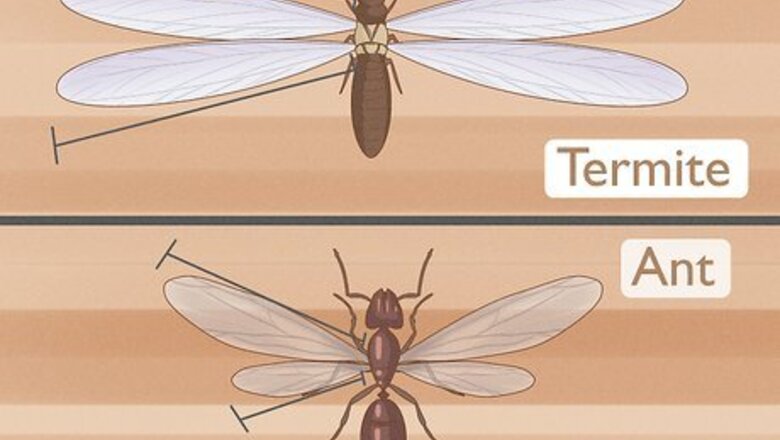
views
- Termites have front and back wings that are the same length, while a flying ant’s front wings are longer than their back ones.
- A flying ant’s antennae are bent, or elbow-shaped, while a termite’s antennae are straight.
- Flying ants have a noticeable, cinched-in waist while a termite’s body is about the same width all the way across.
- Control for termites by spraying pesticide around the foundation of your home. To kill flying ants, spray pesticide directly into their nest.
Wings
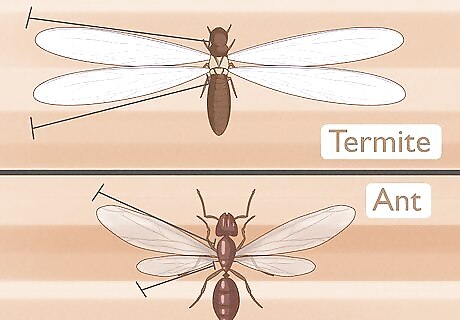
A termite’s wings are the same length, while a flying ant’s are unequal. You’ll know that you’re looking at a termite because their front and back wings are the same length. However, a flying ant’s front wings are noticeably longer than their back ones. Termites’ wings tend to be a cloudy white color, while flying ants’ are usually brownish and more transparent.
Antennae
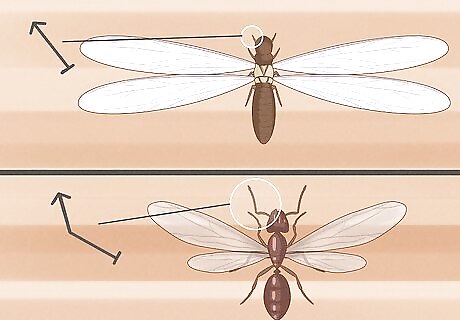
A flying ant’s antennae are bent, while a termite’s are straight. This is another sure-fire way to tell flying ants and termites apart. An ant’s antennae are bent into an elbow shape and look smooth. On the other hand, a termite’s antennae poke straight out from their head. If you can get a closer look, you’ll also see that their antennas are beaded, not smooth.
Body
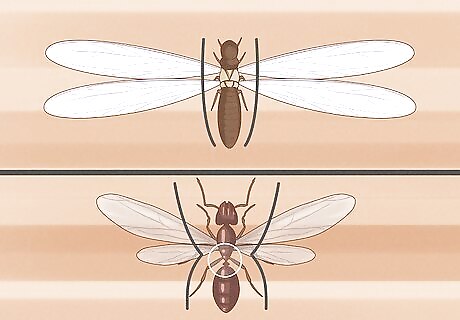
Flying ants have a noticeable waist while termites do not. Ants are well known for their cinched-in waist. This clearly differentiates their thorax, or the middle segment of their body, from their abdomen, or end segment. Termites do not have a noticeable waist like this. Their bodies are about the same width across from their head to their abdomen.
Coloring
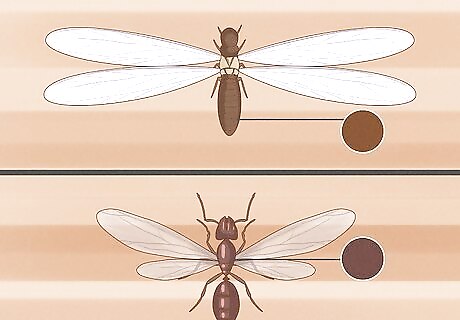
Unlike termites, flying ants can be reddish in color. Termites usually only look black or brown. While flying ants also come in black and brown varieties, they often look reddish, too. So, if the insect in your home looks like it’s more on the red side, it’s probably a flying ant.
Size
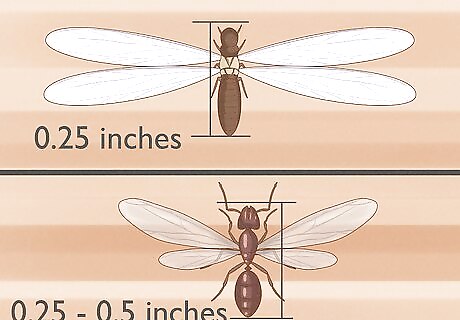
Termites are uniform in size, while flying ants often vary in size. Most termites are all about the same size, measuring to just 0.25 inches (0.6 cm) long. While flying ants can also be that small, their sizes vary more widely than termites. You might see one that’s 0.25 inches (0.6 cm) long and another right beside it that’s 0.5 inches (1 cm) long! In general, watch for an infestation if you see more than a dozen flying ants or termites in your home. You’ll usually see hundreds of insects flying about during an infestation, but finding more than a dozen can mean a nest is close by.
Diet
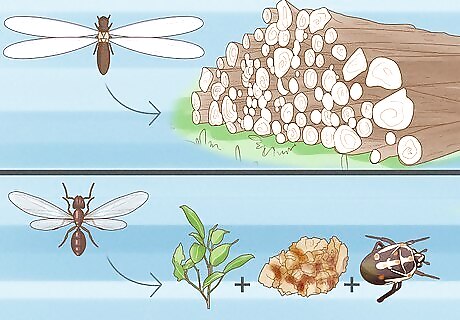
Termites eat wood, while flying ants eat plants, insects, and crumbs. One of the most interesting facts about termites is that they eat wood. They are actually one of the few animals that are able to break it down and use it as fuel! Though flying ants like wood, they’re not interested in eating it. They are omnivores, meaning they eat plants, other insects, and any crumbs they can find. Always wipe up crumbs and spills as soon as they happen. Flying ants munch on anything they can find, so they’re often attracted to food and liquids that are left out.
Habitat

While both live near wood, flying ants prefer moist wood. Termites and flying ants both share a love of wood, usually building their nests in or by tree stumps and wooden structures. However, flying ants are a bit more picky than termites. You’re more likely to find them near damp wood than dry. To prevent either bug from entering your home, store firewood and other wooden materials high off the ground and away from your house. Also trim back any tree branches that touch your home; branches that touch your house can become pathways inside. Because flying ants love moist wood, they often build their nests behind sinks, dishwashers, under bathtubs, by window and door frames, or anywhere with an active leak. You will never see termites walking on the grass outside unless there is something wrong with it. They stay in moisture and will not be wandering around like ants.
Nests
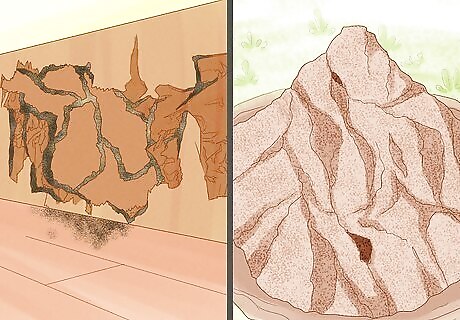
Flying ants create cleaner nests and tunnels than termites. Both insects love to tunnel through wood to build their nests. However, a flying ant’s nest looks smooth, as if it’s been sanded down. Termites’ tunnels are a lot messier. As they eat wood, they leave behind a mud-like substance that covers their tunnel walls. Finding flying ants or termites in your home is not always a sign that you’re dealing with an infestation. They might just have a nest near your home.
Signs of Damage
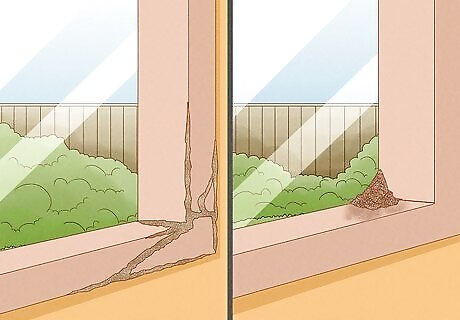
Termites make mud-like tunnels while flying ants leave behind sawdust. One of the tell-tale signs of a termite infestation are thin, mud-like tunnels running down your house’s foundation. Other common signs of termite damage are cracks along your foundation and sagging floors. When flying ants dig through wood, they leave sawdust in their wake. If you find any trails of it around your home, that might be a sign that a nest is nearby. Generally, termites cause more structural and foundation damage to homes than flying ants. While no one wants to find termites in their home, the good news is that they eat slowly. It can take several weeks to months for termites to cause damage, so you have plenty of time to get them under control.
Control

Both insects are treated with pesticide, but it’s sprayed in different areas. If you’re dealing with a termite infestation, the best way to get rid of them is to spray termite pesticide around the perimeter of your foundation. On the other hand, kill flying ants by finding then spraying their nest directly with pesticide. The best way to find a flying ants’ nest is to watch where the ants go. Also check for their nest around moist areas like bathtubs, sinks, and anywhere you see their sawdust tracks. Bait is another great way to control termites and flying ants. For termites, place their bait stations about every 10 to 20 feet (3-6 m) along your house’s perimeter. For flying ants, set ant bait anywhere you see them roaming. If you don’t feel comfortable treating your home, contact a pest control service.
Lifespan
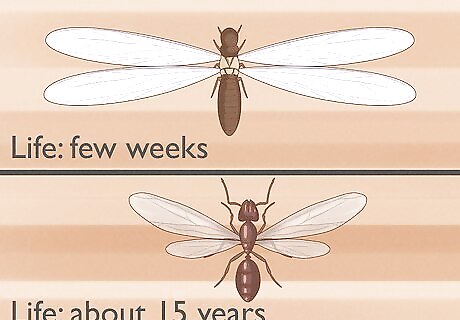
Generally, termites live longer than flying ants. It might be shocking to learn that termites can live for several years! Even more surprising is that a termite queen can live for decades. Like most insects though, flying ants generally only live for a few weeks. However, their queens also live for a long time, about 15 years. Termites and flying ants also go through different life stages. Termites only have 3 life stages–egg, larva, and adult–while flying ants go through an additional pupa stage.


















Comments
0 comment